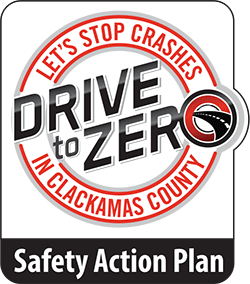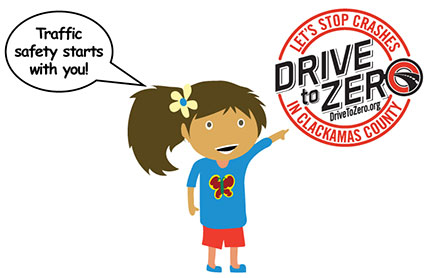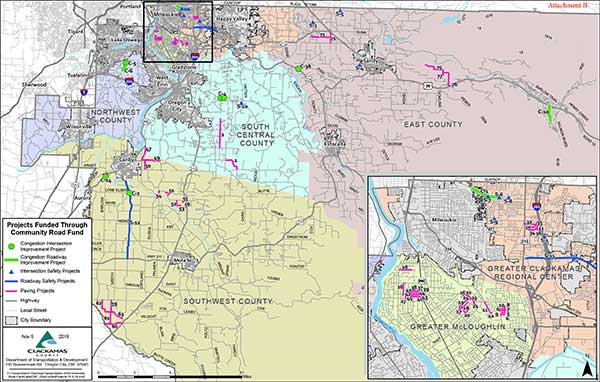Traffic Complaint Form
Do you have a problem with speeding or other unsafe driving in your neighborhood? Let the Clackamas County Sheriff's Office know using this online form.
You may also download the Traffic Complaint form (PDF) and mail it to us.
Do you have a problem with speeding or other unsafe driving in your neighborhood? Let the Clackamas County Sheriff's Office know using this online form.
You may also download the Traffic Complaint form (PDF) and mail it to us.
This 15-member committee of community members works with staff to:
Please note: We do not repair or maintain city and state roads or highways. Report city road concerns to the respective city, and state road concerns to the Oregon Department of Transportation (ODOT) online or 1-888-ASK-ODOT. If you see a road problem — hazardous or non-hazardous — please let us know.
Pothole response: After we receive reports of potholes, we’ll investigate each one and fix them within 7 days as they are confirmed.

Our goal is to get to zero fatal and serious injury crashes by 2035.
For more information, email us at drivetozero@clackamas.us.
From 2009 to 2015, 183 people were killed in traffic crashes in Clackamas County. Another 795 people suffered serious, potentially life-altering injuries. In addition to the tragedy of this loss of life and quality of life, the economic impact of these and other less severe crashes was greater than $100 million per year during this period. A survey of residents found that most believe that the only acceptable number of fatal and serious injury crashes in Clackamas County is zero. Given this belief, the county has set a goal to eliminate fatal and serious injury crashes by 2035. This plan is the roadmap to achieve this goal.
Clackamas County has a goal to eliminate fatal and serious injury crashes on its roads by 2035. Part 1 of Clackamas County’s Drive to Zero Safety Action Plan describes the broad areas on which the county, its partner organizations, and its residents must focus to achieve this goal. These emphasis areas represent an evidence-based approach to reducing fatal and serious injury crashes. They are based on a review of crash data in Clackamas County and best practices from local, national, and international sources. Notably the emphasis areas align with those of Toward Zero Deaths: A National Strategy on Highway Safety , of which the county is a proud partner, and the Oregon Transportation Safety Action Plan, 2021.
Thousands of people are involved in traffic crashes in Clackamas County each year, and dozens of families are faced with the tragedy of severe crashes that cause potentially life-threatening injuries or even death. We are committed, as a county, to tackle the challenge of eliminating severe crashes by collaborating among our agencies and partnering with community stakeholders and nonprofit associations. This collective multipronged approach will advance our shared goal of eliminating traffic fatalities and serious injuries on Clackamas County roads by 2035.
This Transportation Safety Action Plan (TSAP) is a starting point and a dynamic framework for moving forward. Preventable serious injuries and deaths from traffic crashes pose a public health concern to all who live, work, play, and travel through Clackamas County. This TSAP builds on data driven strategies to increase health outcomes by improving the built environment and engaging county residents to help build a community that supports a healthy culture of safety. Everyone in Clackamas County has a vital role in preventing crashes. We ask you to embrace the affirmation that TRAFFIC SAFETY STARTS WITH ME!
Throughout this plan you’ll find opportunities to take action and help us in our Drive to Zero.


Projects funded through the Community Road Fund increase safety, relieve congestion and maintain local roads.
The county has committed to spending the approximately $5.5 million per year of Community Road Fund revenue on three major road priorities. On Nov. 12, 2019, the Board of Commissioners approved recommendations from the Community Road Fund Advisory Committee, the Traffic Safety Commission and staff to fund the following projects over the next 5–8 years. More specific information about the exact timing of the projects will be shared as it is available.

View our projects map.
The vehicle registration fee is a consistent source of local, countywide revenue that allows us to complete projects most important to our residents and businesses. Revenue from the fee funds the Community Road Fund program.
Clackamas County was the only county in the Portland metropolitan area without a local source of funds to maintain its roads and build improvements. With the most miles of roads, Clackamas County continues to receive the lowest amount of funding to maintain and improve roads, bridges, bike lanes, sidewalks, traffic signals and more.
| Multnomah County | Washington County | Clackamas County | |
| Local Gas Tax | $6.8 million | $2.1 million | $0 |
| Local Vehicle Registration Fee | $34.3 million | $7.8 million | $5.5 million |
| Local Property Tax | $0 | $35 million | $0 |
| Road District | $0 | $3.7 million | $0 |
| Total Annual Revenue | $41.1 million | $48.6 million | $5.5 million |
Learn more about the 15-member Advisory Committee and what they do.
Ride-Along with Pavement Management Specialist
Take a ride with Pavement Management Specialist Grant Williams on ClackCo roads to learn about the status of our local, residential roads and how a dedicated source of local funding will allow us to begin making improvements.
Ride-Along with Traffic Engineer
Take a ride with Traffic Engineer Joe Marek on ClackCo roads to see how a dedicated source of local funding could improve the safety of our roads.
Ride-Along with Assistant Director of Transportation
Take a ride with Assistant Director of Transportation Mike Bezner on ClackCo roads to see how a dedicated source of local funding could improve the safety of our roads and relieve congestion.
ClackCo Reads Mean Tweets
We heard your comments about the recent ordinance to ensure we have a way to pay for local road improvements. Some were nice, some were not so nice. Our employees took turns responding. Hear what they had to say and learn more about how the Community Road Fundfrom will reduce congestion, improve safety and maintain local roads.
On Jan. 28, 2020 the OGLO Policy Committee took the following actions:
Final Report (accepted by Policy Committee Jan. 28, 2020)
Executive Summary & Report
Appendices A-D
Appendices E-G
Policy Committee Meeting #4 - Jan. 28, 2020
Press release - Jan. 28, 2020
The CC HB2017 TAC was formed in response to the Oregon State Legislature’s passage of House Bill 2017, which established the Statewide Transportation Improvement Fund (STIF).
All meetings are open to the public and include time for public comment.
| Aug. 18, 2022 | |
| June 10, 2022 |
The Advisory Committee, made up of representatives from public transit agencies and diverse groups within Clackamas County, is responsible for:
For more information about the Clackamas County HB2017 Transit Advisory Committee, contact:
The Statewide Transportation Improvement Fund (STIF) was approved by the Oregon Legislature as part of House Bill 2017, Keep Oregon Moving. STIF provides a new dedicated source of funds to expand public transportation to access jobs, improve mobility, relieve congestion and reduce greenhouse gas emissions around the state.
STIF is funded by a new state payroll tax of one-tenth of one percent. The average employee contribution of less than $1 per week is expected to generate $115 million each year for improved public transportation.
STIF may be used to support the effective planning, deployment, operation and administration of public transportation funds, including:
The law requires the establishment of advisory committees to help the qualified entities (mass transit districts, transportation districts, Indian tribes or counties in which no part of a mass transit or transportation district exists) to advice on projects to be funded by STIF.
An active commercial vehicle inspection program helps make the roads safer for the residents of Clackamas County and the motoring public. State law (ORS 810.530) authorizes weighing and inspecting commercial vehicles in excess of 10,000 pounds.
There are two levels of truck inspections, Level I, the highest level, and Level II. When a commercial motor vehicle passes a Level I inspection, the vehicle receives a CVSA (Commercial Vehicle Safety Alliance) sticker and is considered to have received its annual inspection.
Level I inspections are the most extensive, with an inspection of the operator qualifications and vehicle condition; they always involve 2 inspectors and usually take 20-60 minutes.
A Level I inspection includes a check of the following items.
For the driver
For the vehicle
A Level II inspection — known as a walk-around driver/vehicle inspection — includes most of items included in Level I, but excludes items that need to be inspected by getting underneath the vehicle.
In general, each side of the truck cab or other power unit must display:
The letters and numbers must “contrast sharply” with background colors and be large enough to be seen from a distance of 50 feet during daylight hours when the vehicle is stationary.
Exceptions:
Commercial vehicle permits support county and state residents and businesses by helping to ensure the safe and efficient travel of commercial motor vehicles on public roadways.
Many commercial vehicles require an over-dimensional permit, which allows a motor carrier to safely move a load that exceeds the maximum size and/or weight limits in state law. Permits can be provided for a single trip or for continuous operations. A permit spells out the conditions for moving the load, including routes, so the over-dimensional loads can be moved safely without mishaps.
Issued for an individual vehicle to travel on state or county roads.
Single Trip Permit (STP)
Clackamas County Road Permit
A blanket permit issued by Clackamas County for a motor carrier company to allow its vehicles to use a specific roadway. To apply, contact MotorCarrierSafety@clackamas.us.